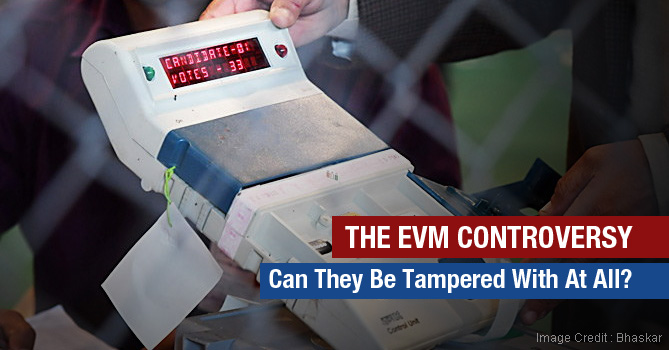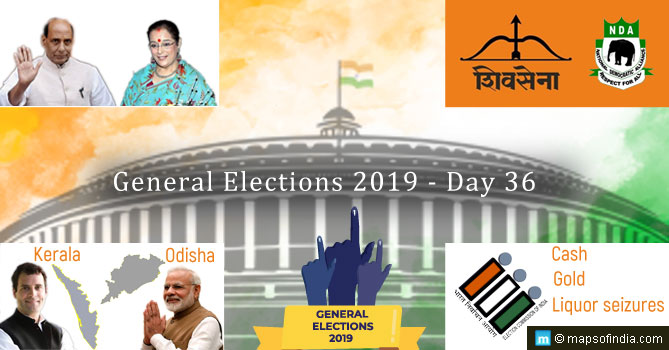The latest round of state legislative assembly polls in India – held across the five states of Manipur, Uttar Pradesh (UP), Uttarakhand, Goa, and Punjab – have raked up a new debate about the validity of the Electronic Voting Machines (EVMs) and the electoral process.
In UP, the Bharatiya Janata Party-led NDA recorded a landslide victory bagging 325 of the 403 seats. The Bahujan Samaj Party (BSP), which once controlled the majority in the state managed to secure only 19 seats. BSP supremo, Mayawati, soon came up with vote tampering allegations and alleged that the EVMs had been rigged. “Either the EVMs did not accept votes other than the ones that went to BJP, or the votes of other parties have gone to BJP,” she said. She asked for re-elections with ballot papers.
Of the 117 seats in the Punjab state assembly, the Indian National Congress (INC) bagged 77. The Aam Admi Party (AAP)-Lok Insaf Party won 20 seats, while the BJP-SAD (Shiromani Akali Dal) combine won only 15 seats. Following this defeat, AAP leader Arvind Kejriwal also alleged that the EVMs were rigged.
A Closer Look At The EVMs – Can They be Tampered With?
The EVMs were manufactured in 1989-90 and were initially used during the 1998 state legislative assembly elections in 16 constituencies of Madhya Pradesh, Rajasthan, and Delhi. They are manufactured by Bharat Heavy Electricals and Electronic Corporation of India and by 2000, all states of the country switched to EVMs, doing away with the ballot paper system.
According to the Election Commission, each EVM can record a maximum of 3,840 votes. The number of voters in a polling station does not cross 1,500 and adequate EVMs are provided for in the assembly and Lok Sabha polls.
EVMs Difficult To Manipulate
The earliest allegations of EVM tampering arose in 2009. Back then, investigative reports suggested that such an exercise may be a very difficult one if not outright impossible. Unlike in the US, EVMs in India are not connected by a network. This means that each individual EVM will have to be “fixed” to be tampered with. Given the great number of people involved in the electoral process – polling officials, local police, paramilitary personnel, independent observers, media and reporters, independent photographers, and voters – it would take the involvement of a great number of people to tamper with the machines and influence the outcome in a substantial way. Keeping such an exercise under wraps is near to impossible.
The EVMs have, on the other hand, managed to eliminate the handicaps and risks involved in using ballot paper. Chances of fraud and manipulation have been reduced greatly. Counting ballot papers used to take days, the counting of votes only takes hours now. Booth capturing and altering the mandate at the counting stage are virtually non-existent.
On an average, an EVM can record a maximum of five votes a minute. This makes 300 votes an hour. Tampering one individual EVM is hardly enough to influence the mandate significantly. To rig multiple EVMs, one will require access to the machines individually for long periods of time – an act that is unlikely to go unnoticed.
In 2014, the Election Commission of India said that there were 814.5 million people eligible to vote in the country. This makes India the largest democracy and EVMs the only viable alternative.
EC Dismisses Allegations
The Election Commission has dismissed any allegations of EVM tampering and said that “elaborate technical and administrative safeguards” had been put in place and “error-free functioning” had been ensured. Eighty-thousand of the EVMs used in UP had been brought in from Tamil Nadu, seventy-thousand from West Bengal, and twenty-thousand from Kerala.
They had functioned faultlessly in the legislative assembly polls last year, ruling out any manipulation at the manufacturing level too. There also arises the question of how the EVMs were tampered to favour BJP in UP and Uttarakhand, and to favour Congress in the other states.
Voter-Verified Paper Audit Trail (VVPAT)
In October 2013, the Supreme Court of India directed the EC, in response to a PIL filed by Subramanian Swamy to introduce the Voter-Verified Paper Audit Trail (VVPAT). Introduced initially in the 2014 Lok Sabha elections, the VVPAT shall be fully implemented by 2019.
It is a system which will allow voters to confirm that the vote cast by them matches the vote recorded by printing the details on a paper slip. Though the voter will not have access to this slip, it can be used to recount the votes, or to check in case of discrepancies.
As of the current state elections, both the AAP and the BSP have no evidential basis for their allegations of EVM tampering. For now, both parties have to remain content with the mandate of the majority and abstain from questioning the integrity of the Election Commission personnel.
Read More
How Counting of Votes is Done in India






